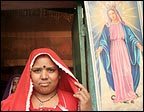 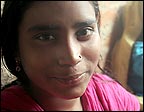 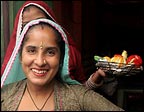 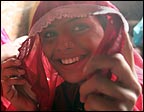 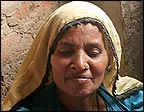
Kathputli
(Puppeteers) Colony, New Delhi. Click on a picture to enlarge.
Kathputli
Colony (Monday , February 12)
The
more I visit Delhi the more snatches of the best history of India
come back to me. In “Midnight’s Children,” Rushdie
writes about the acrobats’ colony, which no one can ever demolish
and relocate, because it whirls around the city, unfound and undefeatable.
 The
puppeteers’ neighborhood isn’t quite so elusive. I arrive
with a colleague at its entrance this past week to find bands of
children performing somersaults in between trying to pin each other
to the ground, not all in good sport. Boys and teenagers ask us
whom we want to see, if we want to see the Trust. It sounds rather
too centralized, like some place where one may be made to ask for
many permissions, pay fees and fill out forms, so we decline, saying
vaguely that we want some information on puppeteers. The
puppeteers’ neighborhood isn’t quite so elusive. I arrive
with a colleague at its entrance this past week to find bands of
children performing somersaults in between trying to pin each other
to the ground, not all in good sport. Boys and teenagers ask us
whom we want to see, if we want to see the Trust. It sounds rather
too centralized, like some place where one may be made to ask for
many permissions, pay fees and fill out forms, so we decline, saying
vaguely that we want some information on puppeteers.
So on up the road, as kids with metal batons twirl circles made of
twisted metal, and youths with curling hair and earrings, vaguely
rakish looking, walk past. It’s like being backstage at the
circus, or at a Coney Island freak show. Women in Rajasthani dress
– long tunic and billowing skirt with embroidered fringe,
topped with a veil tucked demurely yet fetchingly into the midpoint
of the blouse – peak from windows, some stirring large vats
of meat curry. This will be sold to the wedding singers who return
late at night from marriage celebrations.
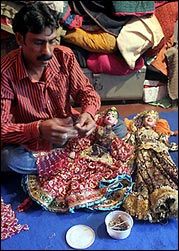 As
we meander we fortunately stop at the signboard of one Santosh Bal
Bhatt, International Puppeteer, whose sign proclaims that he (or
rather his deceased father) has been to Dubai and Qatar, Spain,
France and Holland. The sign is outside a little shack with a rope
roof. Inside a large puppet is covered with a cloth and one the
wall opposite, a picture of Bal Bhatt with a garland. As
we meander we fortunately stop at the signboard of one Santosh Bal
Bhatt, International Puppeteer, whose sign proclaims that he (or
rather his deceased father) has been to Dubai and Qatar, Spain,
France and Holland. The sign is outside a little shack with a rope
roof. Inside a large puppet is covered with a cloth and one the
wall opposite, a picture of Bal Bhatt with a garland.
Santosh Bhatt sets out two grimy plastic chairs and takes out a
book of commendations and photographs. One, from the British embassy
enertainments committee, thanks him for a performance at a Christmas
party several years ago. “Which proved a success,” it
says.
The
women of the family are especially keen to see and talk to us, especially
since the girls are pulled out of school at adolescence because
of the presence of teenage boys. "It's our custom," says
one of the girls wistfully, after practising a little of the English
she learned from a female teacher who used to come to the house
before she got a job elsewhere.
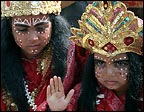 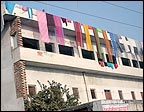 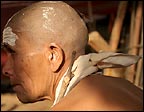 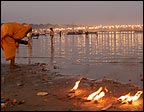 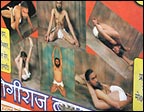
Kumbh
Mela, Allahabad, Uttar Pradesh. Click on a picture to enlarge.
Kumbh
Mela (written Sunday, February 4)
Little
girls dressed as Ram and Sita from the epic. Holy men, wearing saffron,
their foreheads marked in vertical lines, riding in a Maruti Zen.
And washing. Lots and lots of washing. On a white house, on the
main drag of the Kumbh Mela fairgrounds, long colorful saris hung
out to dry, worn earlier no doubt by pilgrims who had come to bathe
in the waters at the point where the waters of the Yamuna and Ganga
meet. The Sangam.
Some
words, events, facts don't become real to you until you see them
in action. So too with sangam, a word I knew the meaning from looking
it up: confluence. But "confluence" is abstract -- without being
poetic -- and the sangam itself is very real, an actual place that
you can point to or ask to go to in a boat (it costs 25 rupees but
may be less depending on what you look like and the time of year.
Or it could be more). It is also a lesson in geography -- if you
didn't remember the course of two of India's holiest rivers before
you will now. The word has a poetry too it, but you don't feel it
to till you see people at the sangam, bathing, frolicking, covering
themselves in mud. Joyful. So, this is the meaning, this is why
a certain sort of person's eyes might light up at the word.
Other
words one learns at the Kumbh Mela: Maun. Amavasya. Silence and
new moon. The latter marks the holiest of the bathing days, the
former is one of the ways in which to mark it. Akhara: Literally,
wrestling camp. But now, more or less the equivalent of the word
"order." As in Benedictine or Dominican, if we were talking
Catholic monks. In this case the names are Udasin, Juna, Maha Nirvani
and so on. Some orders are Vaishnavite, followers of Vishnu, the
preserver. Most orders appear to be Shaivite -- followers of the
god Shiva, the destroyer, he of the matted dreadlocks and cobra
necklaces, who sits in meditation on Mount Kailash in the Himalayas.
The Ganga arises from his hair and flows down the mountains and
through the north Indian plains to Allahabad. Once it meets the
Yamuna, the two flow as one to Bangladesh and empy into the Bay
of Bengal. Geography and mythology are more or less in agreement.
I felt
I came away from the Kumbh Mela learning a lot -- okay, a little
-- about how some things work. Like the lunar calendar. The trajectory
of the rivers. And what the mela itself celebrates. At some point
in celestial time, the gods and demons joined in churning the ocean
and extracted a nectar of immortality. One of the gods stole it
and set off a battle between the gods and demons over it that lasted
12 days and nights. The gods won in the end, but not before four
drops of the nectar had fallen: one at Allahabad or Prayag. People
there say that Prayag is so holy a pilgrimage site that even the
other gods come on pilgrimage there. Even the other pilgrimage sites
made corporeal come on pilgrimage there.
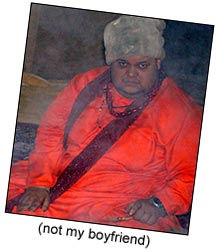 Apparently
the Kumbh bestows many gifts on its pilgrims, not least of which
is the possibility of salvation, of breaking free of earthly life
once and for all and returning to nothingness. As for me, I came
away with a more modest if unexpected blessing -- a sadhu boyfriend.
His name is Baba Ballabhai Bharti and he lives in an ashram in Haridwar.
I have his cellphone but fortunately he only has my office number.
How we met is that on my last day at the Kumbh there was a procession
of Nag mais, new women sadhus who had just been inducted, who were
on their way to conduct their funeral rites to show they had truly
renounced their former lives. I wanted to photograph them so I though
I better ask the babas in the tent near where a group of women were
performing the ceremony. This set off a feeding frenzy for my phone
number and address among some of the more unsavory sadhus, including
one dwarfish, rather drugged looking one with red-rimmed eyes. Sometimes
I really don't agree that beauty is just skin deep. The sadhus that
seemed like really lovely human beings fairly glowed and were rather
beautifu. But others, less instantly likeable, were distinctly unprepossessing. Apparently
the Kumbh bestows many gifts on its pilgrims, not least of which
is the possibility of salvation, of breaking free of earthly life
once and for all and returning to nothingness. As for me, I came
away with a more modest if unexpected blessing -- a sadhu boyfriend.
His name is Baba Ballabhai Bharti and he lives in an ashram in Haridwar.
I have his cellphone but fortunately he only has my office number.
How we met is that on my last day at the Kumbh there was a procession
of Nag mais, new women sadhus who had just been inducted, who were
on their way to conduct their funeral rites to show they had truly
renounced their former lives. I wanted to photograph them so I though
I better ask the babas in the tent near where a group of women were
performing the ceremony. This set off a feeding frenzy for my phone
number and address among some of the more unsavory sadhus, including
one dwarfish, rather drugged looking one with red-rimmed eyes. Sometimes
I really don't agree that beauty is just skin deep. The sadhus that
seemed like really lovely human beings fairly glowed and were rather
beautifu. But others, less instantly likeable, were distinctly unprepossessing.
Anyway
I came to my office upon my return to Kumbh and received the message
that baba had called for me. Initially, since baba also means father,
I though this meant my dad had called. But no. It was that sadhu
who had taken my number, asking if I would like to become his disciple
and learn all about the the life of renunciation first hand.
| |